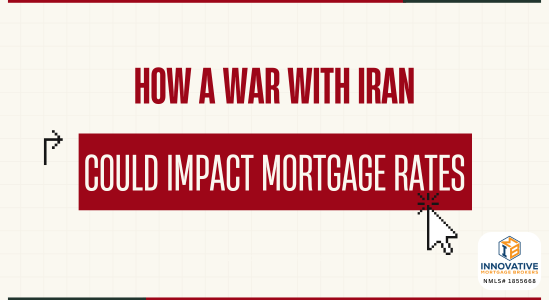As tensions between the United States and Iran continue to escalate, many prospective homebuyers and…
Refinancing 101: A Step-by-Step Journey to Refinancing Your Home or Investment Property in PA or FL
The mortgage world can often feel like a labyrinth, especially if your initial mortgage journey was filled with bumps and hurdles. It’s easy to feel overwhelmed by the complex jargon and intricate processes. But don’t worry, it doesn’t have to be this way. With the right guidance, support, and insight, refinancing your home can be a financially rewarding decision, leading to significant savings and improved loan terms.
We’ve created this step-by-step guide to simplify the process of refinancing your home, whether you’re nestled in the scenic landscapes of Pennsylvania (PA) or soaking up the sun in beautiful Florida (FL). Our goal is to enhance your previous experience, making refinancing faster, easier, and more cost-effective.
Step 1: Define Your Refinancing Goals
Why Refinance?
Embarking on a refinancing journey begins with a crucial question – Why refinance? The reasons behind this decision vary from homeowner to homeowner and understanding your unique objectives is paramount. Some homeowners might be looking to decrease their monthly payments, making their mortgage more affordable in the long run. Others may wish to switch from an adjustable-rate mortgage to a fixed-rate one, seeking stability in their financial plans.
Another common motivation behind refinancing is to tap into the home’s equity. This can provide a substantial cash reserve for major expenses like home improvements, educational costs, or even to consolidate high-interest debts.
Understanding your specific goals not only helps you determine the best refinancing option but also shapes the course of your refinancing journey. It allows you to make informed decisions, aligning your refinancing strategy with your long-term financial aspirations.
Here are some potential refinancing goals:
- Reducing Monthly Payments: If your current mortgage rate is higher than prevailing market rates, refinancing could help you secure a lower rate and reduce your monthly payments.
- Switching Loan Programs: Changing from an adjustable-rate mortgage (ARM) to a fixed-rate mortgage (FRM) can offer predictability in your monthly payments, shielding you from future interest rate hikes. Also, if you are currently in a balloon mortgage looking to get out.
- Tapping into Home Equity: If your home’s value has increased, you may choose to refinance and convert some of that equity into cash. This can fund significant expenses such as home renovations, education costs, or debt consolidation.
- Shortening Loan Term: If your financial situation has improved, you might choose to refinance to a shorter-term loan. While this could increase your monthly payments, it could save you money in interest over the life of the loan.
By clearly defining your goals, you’ll be better equipped to choose the right refinancing path that aligns with your financial needs and future plans. Remember, the objective of refinancing should always be to enhance your financial health and bring you closer to your monetary goals.
Step 2: Review Your Credit Score
The Role of Credit Score
Your credit score is a pivotal factor in the home refinancing process. It directly influences the interest rate you’re eligible for, and consequently, your monthly payments and overall loan cost. Hence, reviewing your credit score and understanding your credit report becomes a vital preparatory step before diving into refinancing.
Credit scores are numerical representations of your creditworthiness, based on your borrowing and repayment history. Lenders rely on these scores to evaluate the potential risk associated with lending you money. A higher credit score typically translates into lower interest rates because lenders perceive less risk in loan repayment.
Here are some ways to review and manage your credit score:
- Access Your Credit Report: You can request a free copy of your credit report from each of the three major credit reporting agencies – Equifax, Experian, and TransUnion – once a year through Annualcreditreport.com. This report provides a detailed overview of your credit history.
- Review Your Credit Report: Scrutinize your credit report for any inaccuracies or discrepancies. If you spot any errors, such as incorrect account information or fraudulent activity, dispute them immediately with the respective credit bureau.
- Improve Your Credit Score: If your score is lower than you’d like, consider taking steps to improve it before applying for refinancing. This could include paying down debts, maintaining a low credit utilization ratio, and making all payments on time.
- Monitor Your Credit Regularly: Keep a regular check on your credit score. Numerous online platforms allow you to check your credit scores for free.
By addressing any discrepancies and areas for improvement in your credit report beforehand, you enhance your chances of securing a favorable interest rate and making the process smoother.
Step 3: Assess Your Home’s Equity
Understanding Home Equity
Home equity is a powerful financial tool that represents the portion of your property you truly own, free and clear of any mortgages or liens. Simply put, it’s the difference between the current market value of your home and the outstanding balance on your mortgage. As you pay down your mortgage over time or as your home appreciates in value, your equity grows.
Most lenders require at least 20% equity before approving a refinance. This is because a higher amount of equity translates into a lower risk for the lender, making you a more attractive borrower.
Here’s how to gauge your home’s equity:
- Determine the Current Market Value: The first step is to get an accurate estimate of your home’s current market value. You can do this by hiring a professional appraiser, using an online home value estimator, or comparing recent sales of similar homes in your neighborhood.
- Calculate Your Outstanding Mortgage Balance: Next, find out the remaining balance on your mortgage. You can get this information from your latest mortgage statement or by contacting your lender.
- Subtract to Find Your Equity: Subtract the outstanding mortgage balance from the current market value of your home. The result is your home’s equity.
For example, if your home is worth $300,000 and you owe $200,000 on your mortgage, your equity is $100,000, or approximately 33%.
Knowing your home’s equity can help you make informed decisions about refinancing. For instance, if you have substantial equity, you could opt for cash-out refinancing, allowing you to leverage your equity to secure additional funds for other financial needs. Conversely, if your equity is lower than required, it might be wise to postpone refinancing until you’ve built up more equity.
Step 4: Compare Rates and Terms
Shopping for the Best Deal
In your quest for the perfect refinancing option, it’s essential not to rush into the first offer that comes your way. Shopping around and comparing rates and terms from various lenders can make a significant difference in the long-term cost of your loan.
At Innovative Mortgage Brokers, we understand the importance of finding a competitive deal for your unique situation. Leveraging our extensive relationships with various banks and lending institutions, we strive to present you with a comprehensive selection of competitive mortgage products.
Here are some tips on effectively comparing refinancing offers:
- Understand the Rates: Look beyond just the advertised interest rate. Consider the Annual Percentage Rate (APR), which includes both the interest rate and any fees or additional costs associated with the loan. The APR gives you a more accurate picture of the loan’s true cost.
- Compare Loan Terms: Don’t overlook the loan term – the length of time you have to repay the loan. A shorter-term loan may have higher monthly payments but could save you money in interest over the life of the loan. Conversely, a longer-term loan might offer lower monthly payments but could end up costing more in total interest.
- Consider the Type of Interest: Is it a fixed-rate or adjustable-rate mortgage? Fixed-rate mortgages offer stability with the same interest rate throughout the loan term, while adjustable-rate mortgages can fluctuate, potentially leading to lower initial payments but higher future payments if rates rise.
- Evaluate Lender Fees: Lenders often charge various fees, such as origination fees, closing costs, and processing fees. Be sure to factor these into your comparisons.
- Assess Flexibility: Some loans come with features that provide flexibility, such as the ability to make extra repayments or redraw facilities. If these features are important to you, consider them in your comparison.
- Read the Fine Print: Always read the loan agreement carefully before signing. Understand any penalties, like prepayment penalties or late payment fees, and any conditions attached to the loan.
Remember, the goal is not simply to find the lowest rate but to find a refinancing option that fits your financial situation and aligns with your long-term goals.
Step 5: Apply for Refinancing
Navigating the Application Process
After conducting thorough research and identifying a lender and a loan product that aligns with your needs, it’s time to take the plunge and apply for refinancing. This step involves a series of administrative tasks and financial checks, designed to assess your eligibility.
Here’s what you can expect during the application process:
- Submission of Required Documentation: You’ll need to provide a variety of documents that verify your income, assets, and debts. These may include recent pay stubs, tax returns, bank statements, and documentation of any debts. Additionally, information about the property you’re refinancing, such as the deed of the house, could also be required.
- Credit Check: The lender will perform a credit check to evaluate your creditworthiness.
- Property Appraisal: An appraisal will most likely be conducted to determine the current market value of your home. The appraised value will play a significant role in determining how much the lender is willing to finance.
- Loan Estimate: After your application has been processed, the lender will provide a loan estimate that outlines the terms of the loan, including the interest rate, monthly payments, and closing costs. Review this document carefully to ensure it aligns with what you discussed with the lender.
The refinancing application process requires a fair amount of paperwork and patience, but with careful preparation, it can go smoothly. Remember to ask your loan officer any questions you may have along the way to ensure you fully understand each step.
Step 6: Close on Your New Loan
Finalizing the Refinancing Process
The final step of the refinancing journey is closing on your new loan. After your application has been approved and you’ve agreed to the terms of the new loan, it’s time to make it official. This process involves a few key steps:
- Review the Closing Disclosure: Prior to your closing date, you’ll receive a closing disclosure from your lender. This document provides the final details about your loan, including the loan term, interest rate, monthly payments, and any fees associated with the loan. It’s crucial to review this document carefully to ensure there are no discrepancies between what was agreed upon and what is outlined in the disclosure.
- Prepare for Closing Costs: Closing costs are an inevitable part of refinancing. They typically range from 2% to 5% of the loan amount and cover various fees such as origination fees, appraisal fees, title searches, and more. Be sure to budget for these costs ahead of time to avoid any surprises at closing.
- Sign the Documents: At the closing meeting, you’ll sign a variety of legal documents that finalize the refinance. These documents include the promissory note, which states your commitment to repay the loan, and the deed of trust, which secures the loan with your home as collateral.
- Set Up Your New Payment Schedule: Once the documents are signed, your old loan will be paid off with the new loan funds, and you’ll start making payments according to your new payment schedule.
It’s important to remember that while closing on your new loan signifies the end of the refinancing process, it also marks the beginning of your new financial obligation. Make sure you understand the terms of your new loan and feel confident in your ability to make the payments.
In conclusion, while refinancing can seem daunting, being prepared and understanding each step can make the process smoother and more manageable. With your new loan in place, you’re on your way to achieving your financial goals.
Why Choose Innovative Mortgage Brokers?
Tailored Advice and Expert Guidance
At Innovative Mortgage Brokers, we understand that every client’s financial situation and homeownership goals are unique. Our team provides tailored advice on various mortgage options, enabling you to make informed decisions that best fit your specific needs. We offer guidance throughout the mortgage process, ensuring a seamless and stress-free experience.
Competitive Rates and Swift Processing
Our strong relationships with banks and lending institutions allow us to bring you a broad array of competitive mortgage products. We work hard to find the best fit for your individual needs, ensuring you secure the most favorable terms and rates. Our commitment to efficiency and transparency sets us apart from others in the industry.
Long-lasting Relationships
We’re not just about transactions; we focus on creating long-lasting relationships built on trust, expertise, and personalized service. Join us and experience a mortgage journey that goes beyond the ordinary.





